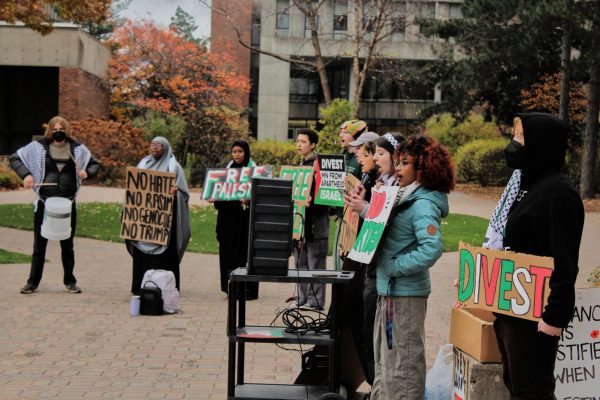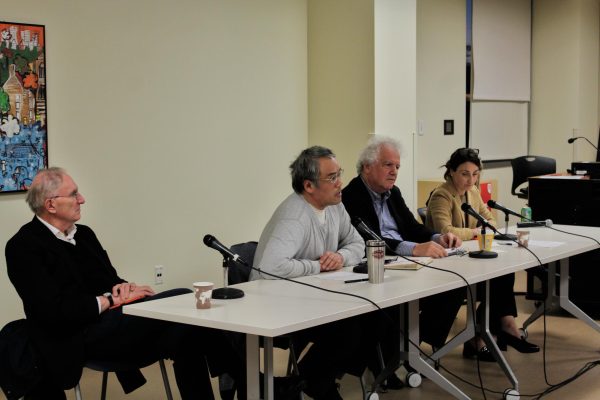Students investigate sexual assaults
Two students and a professor team up to investigate sexual assaults beyond the Clery Act.
Over 500 Hamline students have responded to an online student-created survey regarding sexual assault.The academic survey is designed to gauge the Hamline community’s awareness on sexual assault policies and students’ experiences with sexual assault.
Student investigator and first-year Brynna Morgan was inspired to collect her own statistics on sexual assault after learning about the standards in the Clery Act, a statute that requires all universities receiving federal funding to publish an annual crime and safety report.
Currently under the Clery Act, statistics on forcible sex are required to be recorded and made public, but not sexual assaults that are nonconsensual. Furthermore, only sexual assaults that occur on campus property are required to be published.
“I felt that this was a huge gap in reporting, because it makes it seem like it’s the location rather than the person that’s the catalyst for an assault,” Morgan said. “That is what made me initially frustrated with the reporting system.”
Morgan then went to sophomore Elena Anderson, who is the head of Students Preventing Sexual Violence (SPSV) and the idea for the survey was born.
The two students have been working on the survey with the SPSV faculty advisor and Chair of the Women’s Studies Department Professor Kristin Mapel Bloomberg as an independent study project to assure that it was as ethical and comprehensive as possible.
“This is not just an average peer to peer survey, it’s a legitimate academic enterprise we are using to create some high quality baseline data about our community here at Hamline University,” Mapel Bloomberg said.
According to Anderson, knowledge of the culture of Hamline’s campus was another reason she and Morgan saw the need for this survey. “There tends to be this silence at Hamline, this idea that because sometimes we’re a more progressive school we can’t have this issue,” she explained.
Bloomberg agrees with Anderson. “Elena captures it in a nutshell because, over the many years that I’ve taught here, I’ve seen exactly that attitude among students. I think that creates a barrier to supporting and reporting. [Now] we’re going to have actual numbers that we can talk about.”
In addition, Anderson pointed out that it takes a lot of courage for a survivor to come forward and not having their statistic listed on the report, just because their assault occurred off campus property, would be invalidating.
“From what I know anecdotally, most people don’t report [their assault]. I wish they did. But I also understand there are a lot of barriers that are personal, so you can’t criticize someone for not coming forward,” Anderson said. “We don’t have a high reporting rate at Hamline. So if you do decide to come forward and report it, which takes a lot of courage, and you don’t see your number included in this report, that would suck. It’s kind of invalidating.”
Just because an assault happened off campus, “it doesn’t remove the impact on the community,” Morgan said. “It’s not the full picture.”
Mapel Bloomberg clarified that just because an assault happens off-campus, it doesn’t mean that Safety and Security will not help the student. Their statistic will just not be listed on the Annual Fire and Safety Report.
The 20-minute survey asks students’ awareness of the policies on sexual assault at Hamline, their awareness of resources, if they have been sexually assaulted in their lifetime or since they’ve started attending Hamline and if they know people who have been sexually assaulted since they started attending Hamline.
“This is to see if people can feel out the campus culture for it, or what their perception is,” Morgan said.
There are filters that direct students to different parts of the survey based on their responses, which gets into further details asking when, where and who the attacker was. There is also a “prefer not to answer” option for each question.
Morgan and Anderson went to great lengths to consider the well-being of students taking the survey, which includes trigger warnings and lists campus resources that are available to survivors of sexual assault.
“We wanted to protect the students’ well being. We didn’t want anyone to get triggered by the survey, and then not have the resources to protect themselves. We didn’t want students to take it if they did not feel emotionally able to at that moment,” Morgan explained.
This was one of the reasons Mapel Bloomberg believes it was appropriate for the students to receive academic credit for their work.
“Brynna and Eleana spent an enormous amount of time learning about the best practices for conducting such a survey, dealing with confidential and sensitive material,” Mapel Bloomberg said.
Psychology professor Serena King was one of the professors who assisted the students in creating the survey, specifically in relation to the trigger warnings.
“She pointed us to a number of literature in the field that we read, in addition to her consultation that learned about the best practices with this kind of data,” Mapel Bloomberg said.
“That was extremely helpful,” Morgan added.
The students also reached out to Counseling & Health Services. Director of Student Counseling Hussein Rajput reviewed the survey and directed Morgan and Anderson to data from the National College Health Assessment (NCHA).
The students’ initial goal was to gather 200 responses, which would be considered a valid scope equal to 10 percent of the student population. After reaching that goal, they raised it to 460 responses, because the was the amount that the NCHA had on their survey. Their next goal was 500, which they have now surpassed and they are still collecting results until the last day of April.
Morgan and Anderson have several goals for the survey data. Overall, they will be “looking at all kinds of different literature to see how we measure up on a national scale, and finding the relationships between the answers to our questions,” Morgan said.
First they are planning to compare the results to Hamline’s annual fire and safety reports and the NCHA data to compile a comparative analysis. The annual Fire and Safety Report comes out in October, so it will not be until the fall that they can start their analysis. Most likely they will not disclose the results of the survey to the community until the fall as well.
“Can we report valid results in a meaningful way on a short time line, or are we better off reporting meaningful results in the fall?” Mapel Bloomberg said.
According the to Rape Abuse and Incest National Network (RAINN), sexual assault goes unreported 60 percent of the time. Through their comparative analysis, it will be possible to confer a statistic on how often sexual assault is underreported at Hamline, but they cannot speculate about the data at this time.
As for finding relationships in their own data, looking at the years in school that the students are will be key according to Anderson. “A lot of assaults happen to college students within their first year, even within the first two weeks [of classes,] which is horrible, but is a very big issue with people starting college. Even those questions of ‘what year are you’ are going to be very relevant,” she said.
Morgan hopes other offices and departments on campus will take a look at the data after it is made available to the Hamline community to improve awareness and education on sexual assault.
Based on the data, SPSV is planning to lead educational campaigns for students. “As the group looks at the report they’ll be able to determine what’s best based on their goals of education for the campus community,” Mapel Bloomberg said.
Anderson gave an example of what SPSV might work on. “If people don’t know anything about Title IX we could talk more about that. It will inform our work in that way.”
Currently Hamline students are informed about sexual assault policies during Piper Passages, the orientation period for first years. But Anderson and Morgan don’t believe the system currently in place is enough.
“That’s at a time when students are given so much info, it’s hard to absorb all of that at once. I know it was harder for me,” Morgan said.
In addition, some students such as transfer students don’t go through Piper Passages.
After creating a large comprehensive analysis, the students would like to write a paper for an academic publication, and then present it at the National Women’s Studies Conference in 2015. Morgan already gave a presentation on the survey at the Associated Colleges of the Twin Cities (ACTC) Women’s Studies Conference that was this past month.
One of her other goals is that more universities will use her survey as a model and be proactive. “My hope is that other schools would see it and want to get involved. I would like to make this bigger.”
Morgan believes that creating and distributing the survey through an academic independent study is the best approach to take. “It is not something that you would be able to run through the university,” she explained. “The politics surrounding it are very sensitive, so doing this through an academic department has given us the freedom to ask these questions.”





